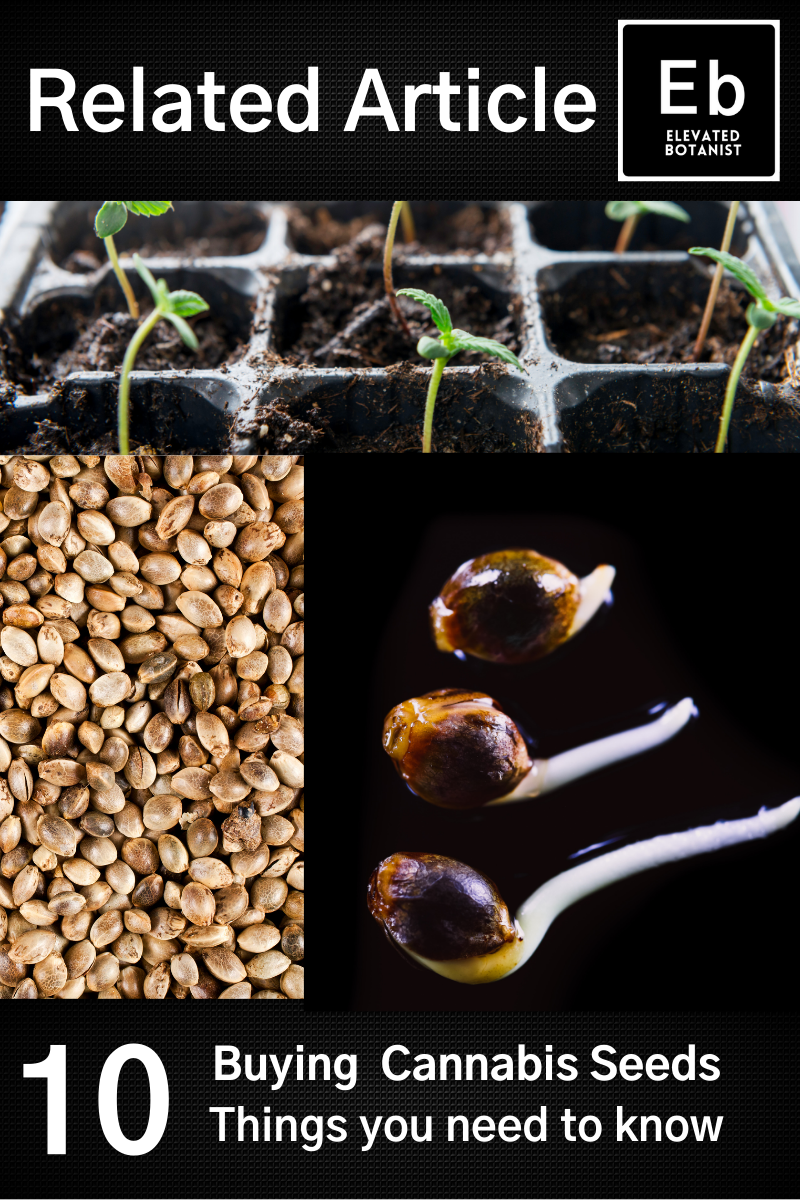How to Pheno Hunt for Outstanding Cultivars
Every seed that you germinate has the potential to change the world (or at least inspire some great Hip-Hop lyrics).
The best plant among a 10 pack of seeds is easy to determine with a little help from your friends.
But how do you locate a truly outstanding cultivar among thousands of candidates that can serve as the basis for your Brand Empire?
You need to develop a phenotyping program.
This requires an understanding of horticulture trial design in the context of cannabis physiology.
I am happy to share my experience in this regard.
Not every cultivator will invest the resources required to sift through large numbers of plants. The future is bright for those of us who do.
Phenotype
A plants phenotype is the sum of every physical characteristic or trait that is expressed in a specific environment.
Phenotypic trait expressions are determined by the interaction between Genetics and Environment. Genetically identical plants (clones) grown in different environments will have different results.
Cannabis is a special crop, and atypical in many important ways.
Cannabis is an obligate outcrosser in most conditions. This means that a combination of DNA from 2 different individuals is required for sexual reproduction. We are obligate outcrossers as well, but in the plant kingdom this feature is unusual.
Outcrossing increases the diversity of phenotypic expression within plant populations.
Cannabis Diversity
Cannabis is among the most ancient of domesticated crops.
Several millennia of co-evolution and prehistoric human selection have provided a diversity of THC rich landrace varietals from which contemporary strains have been developed.
During this period, the Cannabis plant has leveraged its relationship with humans to expand worldwide from its origins in East Asia.
Prohibition effectively sidelined Cannabis from the incredible advancements in plant breeding achieved during the twentieth century.
Clandestine cultivation and trade, and widespread hybridization of this plastic species, have resulted in the diversity of poly hybrid cultivars currently in production.
This germplasm presents a wealth of genetic diversity and the opportunity for significant gain of function. The best cannabis cultivars in the world are yet to be found.
Traits of Interest
The first step in developing a phenotyping program is to identify the traits you are looking for in an outstanding cultivar.
These traits would include quantitative measures like cannabinoid percentage and grams of yield, and qualitative measures including taste and effect.
Horticultural traits like structure, vigor, and pest resistance are as important as market metrics when selecting superior cultivars.
Organizing these traits in order of importance helps to focus trial design on the traits of highest value.
Sourcing Genetics
When traits of interest have been identified this information can be used to source seeds with the highest likelihood of expressing the desired traits.
Experienced seed suppliers will be able to direct you to varieties that are most likely to meet your requirements.
When purchasing seed lots for initial trialing it is important to ensure the continued availability of that variety.
Varieties which have been selected in grow conditions that are similar to yours have a higher likelihood for success.
This is particularly true for outdoor varieties that are subject to uncontrolled climate and pest pressure conditions.
Trait Measurement
Many important traits are quantitative and can be directly measured using various instruments.
Analog tools including calipers and measuring tapes are used to calculate physical traits. Scales are used to calculate root mass and flower yield.
Several emergent technologies promise to make phenotyping more efficient.
Desktop cannabinoid analyzers are available to measure cannabinoids on site, enabling quick and affordable data collection for this important metric.
Advancements in spectral imaging enable traits including trichome density, leaf surface area, and pest resistance to be efficiently measured.
Terpene analysis requires more sophisticated (expensive) lab analysis. Cannabis flowers should be properly cured prior to analysis to preserve the terpenes you want to measure.
Trait Scoring
Trait Scoring enables collection of data about qualitative traits where a direct measurement is impractical.
Pest Resistance Traits are commonly scored using a predetermined 1 to 5 pest severity scale. Accuracy depends on collection of data by experienced personnel and clearly defined levels of severity.
Qualitative flower characteristics must be scored subjectively following product curing.
A 1-10 scoring system is usually employed as this is intuitive for human evaluators. Flower is usually scored on several criteria including appearance, smell, taste and effect, and scores are averaged.
Selection Timing
An important component of efficient trialing is the elimination of many individuals early in the process.
Early selection criteria that can be employed include genetic analysis to eliminate male plants immediately after germination, and assessment of seedling vigor.
Several vegetative characteristics can generally be assumed to be beneficial for greenhouse cultivators. Plants with narrow leaf blades, intermediate internode length, and strong stems will enable airflow and flower support to the benefit of labor efficiency.
For cultivators in vertical farming systems desirable plant structure traits would include tight internodes, and a branchy growth habit (low apical dominance) to allow efficient canopy and height management.
Traits will have various selection costs depending on labor and technology required to measure the trait and the plant growth stage at which the measurement can occur.
Trial Design
The largest possible number of candidate plants should be assessed during several trial repetitions to select the most valuable production cultivars.
Efficient trial design involves both spatial and temporal components. Trial plots are physically located to minimize differences in growing conditions between plots. Individual cultivars are often randomized within test plots, and trait data is collected during the optimal developmental window.
To select for a trait, it must be observable in your environment. You cannot select for PM resistance if that disease is not present in your selection plot.
Variety Trials
Variety Trials are designed to select a variety or strain for seed-based reproduction.
Different varieties are cultivated in separate plots and traits are scored as an average among the individuals in those plots.
In a trial to select autoflower varieties for commercial production, uniformity would be a primary trait to target. When the purpose is to select the best variety for future phenotyping trials, vigor and pest resistance might be more important to determine.
Trait selections can be made by averaging measurements across the plot, or by randomly selecting individual plants within the plot, and averaging the trait data for those individuals.
Cultivar Trials
Commercial cannabis crops are typically propagated by cloning for phenotypic consistency, and an exceptional plant can be multiplied into millions of production cultivars.
Once the varieties with the highest performance potential in your cultivation environment have been identified Cultivar Trials can be performed to select outstanding individuals within those varieties.
This requires assessment of each individual plant’s traits and preserving copies of each candidate until all selection criteria have been performed.
Plants are culled at every opportunity, and plants are cloned as late in the production cycle as possible to conserve cultivation real estate.
The pursuit of exceptional plants includes culling most plants which are germinated. There is no place here for sentimentality.
Replication Trials
It is not possible to choose the one superior plant from a large population within a single crop cycle.
The goal of the first cultivar trial is to choose the top ten percent of plants based on those traits that have been identified as the most important, and which can be most efficiently measured.
Depending on how controlled the cultivation environment is, there can be a high variability in plant performance depending on the location of each plant. Trial repetitions can help to minimize this spatial variability in performance. Many traits like yield cannot be selected for based on one plant.
A typical repetition trial could include propagation of ten clones of the 10% of all cultivars selected in the first round of cultivar trialing, and randomly distributing these individual cultivars within the trial area.
Trait scores can then be averaged among each clone group.
Banking live plants
Cultivar trialing involves banking of large numbers of live plants preserve each cultivars genetics until selections can be made.
A detailed inventory system is required, and individual germplasm Identification (GID) numbers are affixed to each cultivar.
For growers with access to the technology, tissue culture offers the possibility of keeping large numbers of plantlets within a small footprint.
Data Collection
Trial data is collected in the field using a field book. Plant Breeding and Variety testing software platforms incorporate propriety apps to record field data digitally.
There are also open-source digital field books that have been developed due to the importance of this application to food producers globally.
Common features of these tools include prompts, rubrics to define trait scores, scanning of plant tags for plant and plot identification, the ability to attach images to plant records, and the export of all data to CSV or other file types.
Data Analysis
Data only has value when it can be analyzed.
Variety testing software applications provide a diversity of visualization tools to make the information more relevant to decision making. Ancillary information including inventory, pedigree and plot maps, and historic field data are also useful for trial design and execution.
Plant trial data can be analyzed by common spreadsheet applications in most situations. You don’t need to be a data scientist to interpret trait scores, but a basic understanding of statistics will increase your ability to make good decisions based on data.





